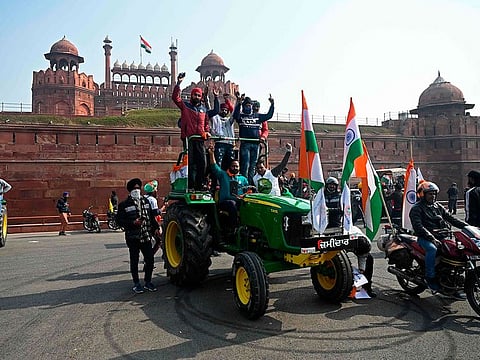Farmers protest faces a severe setback in India
Those protesting in Delhi have lost the moral high ground against the government

On Republic Day most Indians have a feel-good moment when the majestic parade displays national integration, military might, progress of science, and the country’s incredible diversity at Rajpath in New Delhi. This Republic day, however, was like never before.
It was both sensational and deeply sad to see the historic Red Fort in New Delhi occupied by the group of farmers who had turned rioters. TV channels across India relayed images of protesters hitting the police, breaking barricades and creating mayhem.
Most Indians were horrified to see that on this historic day — when we renew our pledge to the Constitution — some Indians did exactly the opposite. By taking the law and order into their hands, those protesting lost the moral high ground against a government that was — till now — looking for an escape route.
A huge self goal
The ongoing farmer’s agitation, conducted at five places on the Delhi border for the last two months, against the new farm laws had been mostly disciplined, non-violent and well-organised. Its optics and politics against the BJP government were also working.
After a few rounds of negotiations, the farmer’s unions were even successful in forcing the government to agree to dilute the laws. Actually, their success against the government attracted many political parties to join them covertly and overtly. The Congress, Akali Dal, AAP, TMC, NCP and many other parties were keen to join the platform.
But, the leaders of the agitation were not satisfied with “partial surrender” of the government. They wanted the government to repeal the freshly-passed laws. Till 26 January the leaders of the farmers agitation were having an upper hand and the government of India was mostly defensive.
In fact the BJP government was having a tough time as the agitation was not only visible and resourceful, but it was quite intelligently planned, too. The Punjabi agitators had a staying power.
Prime Minister Modi and Home Minister Amit Shah have been veterans of launching street agitation when they were in the opposition and have tackled many protests against their government while in power in Gujarat but the current farmers agitation has many layers and the government found little elbow room to handle them.
Perhaps the protests could have taught a lesson or two to the government, but the left-leaning farmer leaders made a strategic error of countering the much-loved official grand parade on Rajpath. It’s a tradition. 26 January is a sacred date in India. People instinctively dislike anything that breaks nationally-followed routine.
It won’t be an exaggeration to say that some of the farmer’s leaders ended up lacking consensus, the same charge they accused the government of, when it rushed the bills in the parliament last year. The parallel ‘tractor march' to the Republic Day parade was their folly.
They selected the Republic Day to grab attention but many Indians viewed it negatively. In people’s eyes Republic Day is never the BJP’s or Modi’s event. It is India’s event. Zero points to the protesters here.
Not under anyone’s control
On January 26 hundreds of tractors came from all directions while the farmer leaders said that the tractor march will be peaceful. The crowd that assembled from the villages and districts of Punjab, Uttar Pradesh and Haryana was politically charged. The movement does have collective leadership but it also means that it’s not under anyone’s control.
That meant that the faultlines of the farmers collective leadership came into play, too. When the united front of farmers agreed to the routes devised by the Delhi police after many rounds of talks, some radical Punjabi farmers opted out and told the media they won’t obey the police.
While the planned tractor march was going peacefully at the pre-fixed routes, many large groups on tractors departed the route and entered Central Delhi and Old Delhi areas.
The police had fairly good intelligence but still, they failed to stop them from rushing in. The forces were overwhelmed by sheer numbers of farmers.
It gave jitters to many in the government to see angry and young farmers reaching quite close to the India Gate. Their intention was to occupy the prestigious India gate area and stay put.
It would have been acute embarrassment for the government but Home ministry was closely supervising the situation. When the farmers seized ITO area, they were pushed back by the Delhi police.
The day belong to the Delhi police which showed restraint. On eve of the parade, cops were under the directive to not open fire on the Republic day. When the farmers ran towards the Red Fort and hit the police force at every barricade, India was shaken for couple of hours.
At the Red fort some of them unfurled the Nishan Sahib flag. This one act narrowed down the farmers agitation in the eyes of public. The government couldn’t change the perception in last two months but miscreants harmed the farmers’ agitation.
Some have suggested that the actor Deep Sidhu was seen leading miscreants in Red Fort. A few farmers leaders have cried foul saying he is a government’s plant. But, there is enough evidence to show that the farmers who breached barricades at Gazipur and other borders had clear intention to occupy heart of Delhi.
The planners of the historic farmers movement of 2020-21 have indeed faced a severe setback.
Sign up for the Daily Briefing
Get the latest news and updates straight to your inbox








